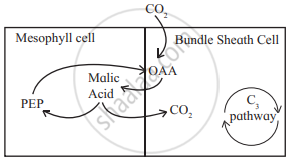Advertisements
Advertisements
Question
Answer the following question.
Why does RuBisCO carry out preferentially carboxylation than oxygenation in C4 plants?
Solution
- In C4 plants, CO2 taken from the atmosphere is accepted by a 3-carbon compound, phosphoenolpyruvic acid in the chloroplasts of mesophyll cells.
- This leads to the formation of 4-carbon compound oxaloacetic acid with the help of enzyme phosphoenolpyruvate carboxylase.
- It is converted to another 4-carbon compound called malate.
- Malate is transported to chloroplasts of bundle sheath cells where malate is converted to pyruvate and releases CO2 in the cytoplasm thus increasing the concentration of CO2 in the bundle sheath cells.
- Chloroplasts of bundle sheath cells contain enzymes of the Calvin cycle.
Thus, due to the high concentration of CO2, RuBisCO participates in carboxylation and not in oxygenation.
APPEARS IN
RELATED QUESTIONS
The head and tail of chlorophyll are made up of ______.
C4 pathway is also called as dicarboxylation pathway because ______.
Answer the following question.
What are the steps that are common to C3 and C4 photosynthesis?
Answer the following question.
Why are plants that consume more than the usual 18 ATP to produce 1 molecule of glucose favoured in tropical regions?
Answer the following question.
In C-4 plants, why is C-3 pathway operated in bundle sheath cells only?
Answer the following question.
What would have happed if C-4 plants did not have Kranz anatomy?
Answer the following question.
How can you identify whether the plant is C3 or C4? Explain / Justify.
Answer the following question.
What is the functional significance of Kranz anatomy?
Correct the pathway and name it.

Where does the conversion of pyruvic acid into phosphoenol pyruvic acid take place?
